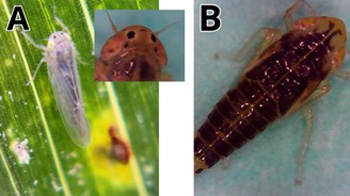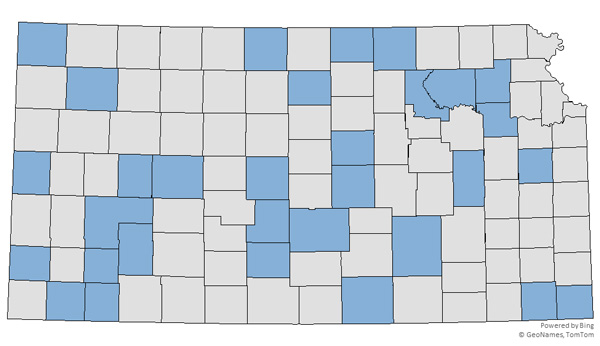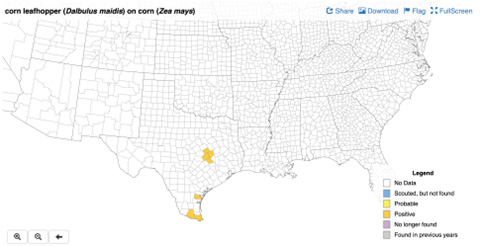Corn stunt spiroplasma (CSS, Spiroplasma kunkelii) and its associated vector (corn leafhopper, Dalbulus maidis) were first confirmed in Kansas during the 2024 corn season. Although most of the positive reports were from field corn, we also confirmed CSS in sweet corn. High levels of disease were found in late-planted and double-cropped corn, leading to potential yield reductions. Corn leafhopper acquires pathogens within minutes of feeding on infected corn plants, but it can take up to 30 days for the leafhopper to be able to infect healthy corn plants during feeding events. The corn leafhopper can also transmit additional pathogens, either singly or in combination with CSS. To date, only CSS has been confirmed in Kansas.
The corn leafhopper is relatively simple to identify under magnification (Figure 1). These leafhoppers are light tan to yellowish-white in color and approximately 1/8” long. Two distinct dark spots between the antennae and eyes are very characteristic of this species. Nymphs lack wings and can vary in color. Like most leafhoppers, all stages move quickly when disturbed and hide in shaded areas of corn plants. All stages can be sampled using a sweep net; a video showing how to sample for corn leafhoppers in mature corn canopies can be found here: https://youtu.be/QgLuWWSwHWU.

Figure 1. Images of a corn leafhopper: A) adult on a corn leaf and magnified view of the two black spots between the eyes; and B) nymph showing dark brown coloration and developing wing pads. Photos courtesy of Brian McCornack, K-State Research and Extension.
Early detection of corn leafhoppers is a vital component of corn stunt management. To help communicate monitoring results in real-time, a monitoring system and webpage have been created to help growers track corn leaf hopper, corn stunt, and other corn diseases (kscorn.com/corndisease). A collaborative effort between K-State Plant Pathology, Agronomy, and Entomology departments, the Kansas Corn Commission, Kansas Independent Crop Consultants, K-State Research & Extension Ag Agents, and Corteva has been initiated to monitor at least three counties in each crop reporting district for corn leafhoppers (Figure 2).

Figure 2. In-season K-Trap monitoring counties. Counties that are blue have at least one trap for CLH and will be monitored weekly during the 2025 Corn Season.
About 33 Kansas participants have already received sticky traps and are beginning to ship them back to track the number and location of corn leafhoppers in the state. Monitoring will continue for 40 weeks. This will help us understand our real-time risk during the growing season. The leafhoppers that are trapped will be tested to see if they carry the pathogens that cause corn stunt disease. Any detections will be added to a map that tracks corn leafhopper detections in Kansas and other states (kscorn.com/corndisease). Additionally, we will be offering free corn stunt disease testing for Kansas corn growers during the 2025 season. Free testing will include both types of samples: corn tissue and corn leafhopper.
The corn leafhopper map, along with a map that tracks the detection of corn stunt pathogens, can be found on Kansas Corn’s website: kscorn.com/corndisease. This page also includes maps for tar spot and southern rust, as well as video updates from K-State Research and Extension.
Corn leafhopper status in 2025
In 2025, the corn leafhopper has only been detected in seven counties in Texas. In Kansas, traps received from Cherokee, Jackson, Haskell, Saline, and McPherson Counties during the week of 04/14/2025 through 04/21/2025 had no corn leafhoppers (Figure 3).

Figure 3. Corn leafhopper (Dalbulus maidis) distribution in 2025.
Visit kscorn.com/corndisease for more information.
Rodrigo Onofre, Row Crop Plant Pathologist
onofre@ksu.edu
Anthony Zukoff, Entomology Extension Associate
azukoff@ksu.edu
Tina Sullivan
tsullivan@ksu.edu